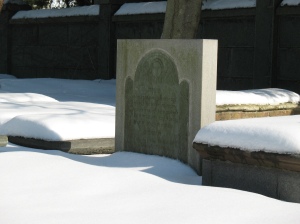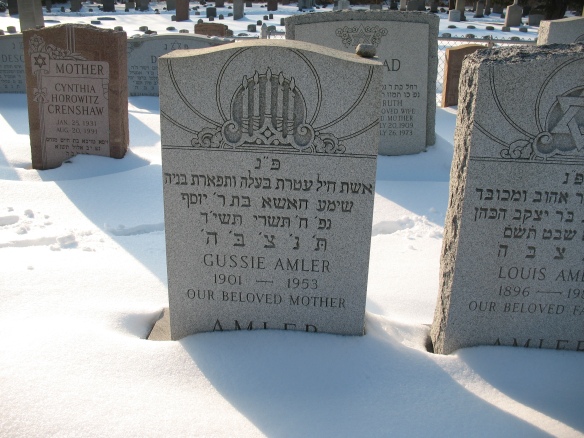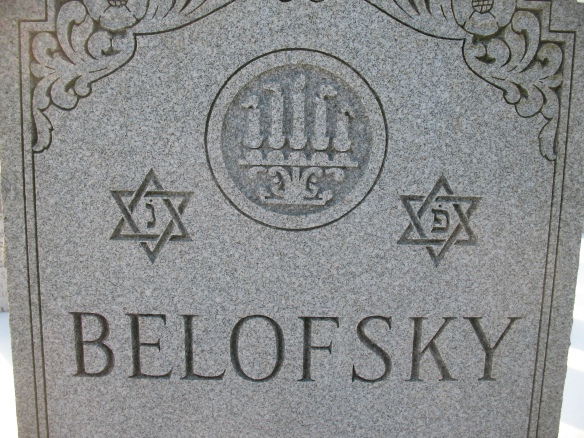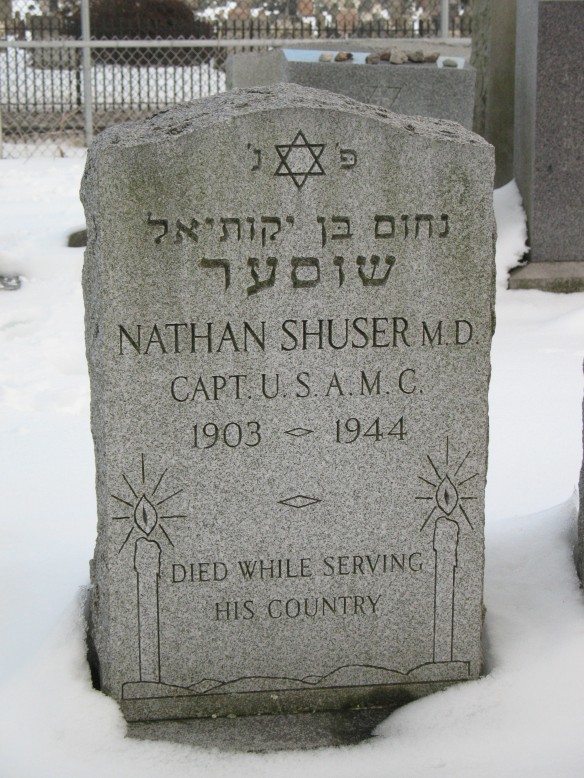
Only the candlesticks are visible above the snow. Newport, RI.
By Ruth Ellen Gruber
Over the weekend, I visited friends in Rhode Island who took me to look at several Jewish cemeteries. I was interested in seeing whether, and if so how, the iconography of candlesticks marking the graves of women was found in America as well as eastern and central Europe. I had wanted to visit the old Jewish cemetery in Newport, near the historic Touro Synagogue (the oldest synagogue in the United States), but this was closed — and in any case, the stones were mostly covered by the thick layer of snow that still lies on the ground after many heavy snowfalls over the past few weeks. I was able only to photograph, at a distance, one stone — which bears carved decoration very similar to that found on the famous Colonial period Christian tombstones — an angel head with wings — over a Hebrew epitaph.

Gate to Old Jewish Cemetery, Newport.

Angel head over Hebrew epitaph. Rebecca, wife of Mr. Polock, d. 1764
There is another, much later, Jewish cemetery in Newport, though, occupying three fenced-off sections in a big municipal cemetery on aptly named “Farewell Street,” and here I found quite a few women’s gravestones bearing the decorative element of candlesticks. The carving was mostly quite simple and rather standardized, though some were slightly more elaborate.

One of the more elaborate tombs.
One tombstone was notable for the way the candles were depicted as flickering, or seeming to be on the verge of flickering out — you find a variation of this motif in Eastern Europe, but with the flames pointing to the center of the candelabra, not to the outside.

Flickering candles
Also interesting (at least to me!) were the couple of tombstone of MEN that employed the candlestick imagery — like the one below, of a Nathan Shuser, a Jewish medical officer killed in World War II.

The most fascinating tombstone to me, however, was the gravestone of Eva (or Hava) Segal, wife of Dov Mordechai Segal, which did NOT bear the candlestick imagery. In fact, it bore a carved motif that I had never seen before — a loaf of bread, with slices cut from it on a plate, and a neatly aligned knife and fork. No candlesticks in sight. To me, the image could symbolize one of several things.
It could refer to the Seudat Havra-ah, the first meal that mourners are served when they come home from the cemetery to start the shiva mourning period. Bread is generally part of this meal — as are eggs. Or it could illustrated that Mrs. Segal was generous (by showing food offered to be eaten.)
But — and this is what I like to think it represents — it could somehow be a pictorial representation of the “women’s commandment” of “taking Challah,” that is, burning a piece of dough when baking bread. (See in the “articles” section of this web site the article “A Mystery on the Tombstones.”)
As I have noted elsewhere, one of the reasons that candlesticks are used to represent women appears to be the fact that lighting the Sabbath candles is the only one of the three “women’s commandments” that lends itself to easy visual representation — in addition to lighting candles and taking Challah, the third commandment is Niddah, or observing the laws of menstrual purity.

Gravestone of Eva Segal, with image of bread
The epitaph does not shed direct light on this — though it praises her generosity. It reads: “A woman of valor; the crown of her husband, has mercy on the poor and guests in her home and acts well and honestly. [She] guided her sons on a straight path.”










